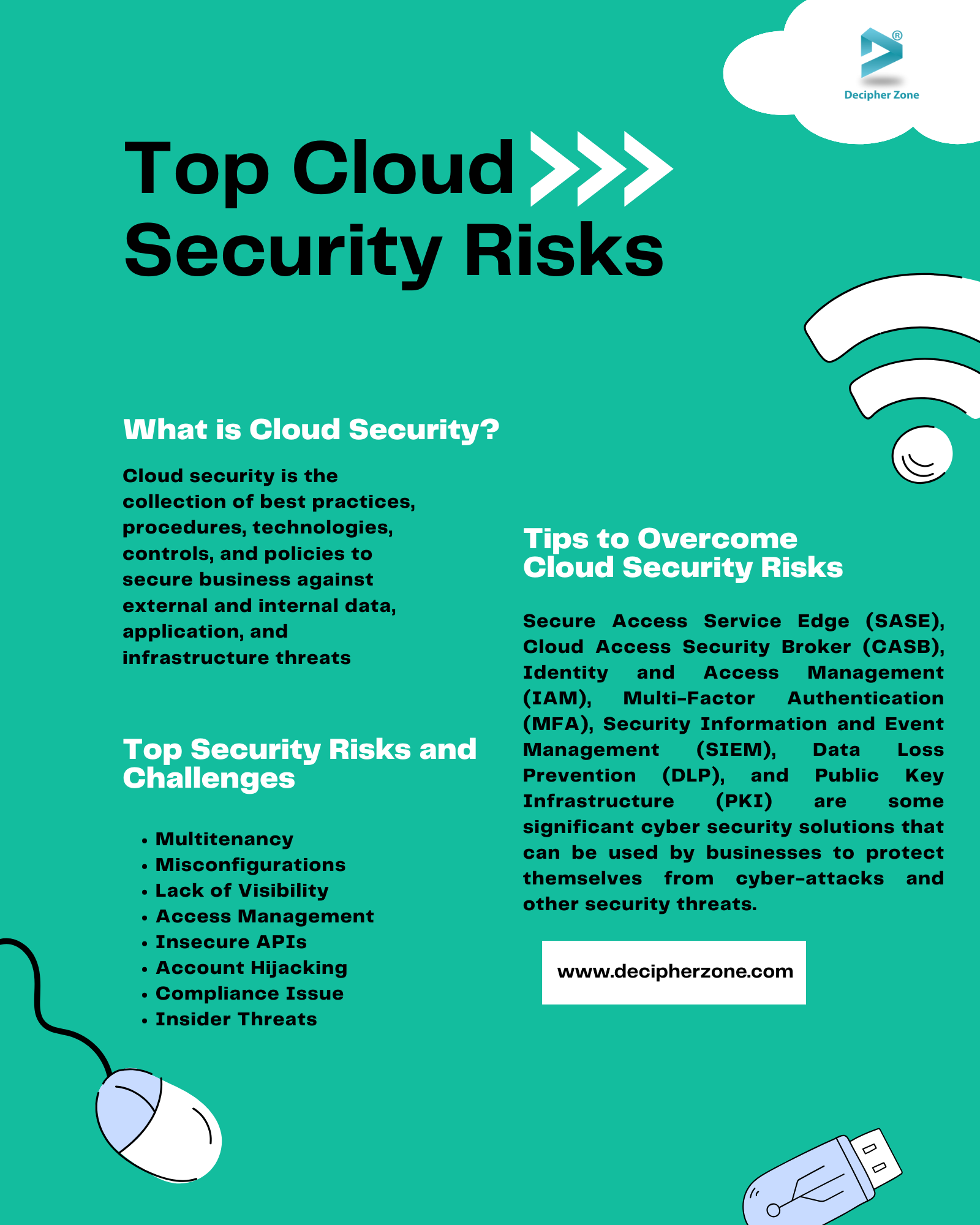Top 8 Cloud Security Risks, Challenges, and Tips to Overcome. As technology advances, more and more businesses are migrating their data to the cloud due to its scalability, flexibility, accessibility, higher performance, quick deployment, and cost savings. However, this also led to a rise in cloud security risks.
You might be baffled by the continuous increase in cybercrime, but it is more or less due to the economic recession. With the rise in unemployment and low income, hackers are creating unavoidable threats for businesses, causing huge losses. It is essential to understand what it entails to overcome cloud security threats.
So, in this article, we will cover everything you need to know about cloud security threats and how to overcome them.
What is Cloud Security?
Cloud security is the collection of best practices, procedures, technologies, controls, and policies to secure business against external and internal data, application, and infrastructure threats. Businesses need cloud security to move toward their digital transformation and adapt cloud-based tools and services.
Cloud security focuses on implementing technologies, tools, processes, and policies to control access, authentication, and access for devices, support regulatory compliance, and ensure data protection.
While cloud security can’t guarantee complete prevention from cyber vulnerabilities and attacks, a well-designed strategy can go a long way to prevent data breaches, enhance compliance regulations, and create robust consumer trust.
Read More: What is Cyber Resilience: Components, Benefits and Threats
Top 8 Cloud Security Risks and Challenges
Some of the most common cloud security risks and challenges faced by businesses are:
-
Multitenancy
-
Misconfigurations
-
Lack of Visibility
-
Access Management
-
Insecure APIs
-
Account Hijacking
-
Compliance Issue
-
Insider Threats
Multitenancy
Multitenancy refers to sharing the same computing resources with multiple clients. In simple terms, multiple consumers of the cloud service provider use the same computing resources to reduce costs by leveraging scaling.
Each tenant in the public or private cloud remains isolated and invisible to other consumers. However, it is crucial to note that in a cyber attack targeting other businesses, one’s hosting service may also be affected as collateral damage.
Misconfigurations
Cloud misconfigurations are the errors, vulnerabilities, gaps, and glitches that occur when poor security choices are made. It is a major cause of data breaches. According to Gartner, by 2025, 90% of the businesses that will not be able to control and configure their public cloud use will cause unnecessary security risks and sensitive data exposure.
Lack of Visibility
The flexibility and scalability offered by cloud-based resources are undeniable, but they also come with their own set of challenges when it comes to network visibility.
As these resources are hosted outside of your corporate network and managed by a third party, traditional network monitoring tools may not be sufficient in providing you with a complete view of your cloud assets.
Access Management
Enterprises can effectively manage and restrict access points on their on-premises systems, but administering them in cloud environments can be a challenge.
This can pose a significant risk for organizations that allow unrestricted access to cloud services from any location or device because it allows attackers to easily gain access to authorized resources with misplaced access control and vulnerable credentials, especially if they do not have a bring-your-own-device (BYOD) policy in place.
Insecure APIs
Application Programming Interfaces (APIs) allow businesses to access services. Using 3rd party monitoring cloud services and APIs, however, can create vulnerabilities and misconfigurations that can be exploited by attackers, especially if the business fails to properly secure APIs.
Account Hijacking
It is a common identity theft attack by cybercriminals to gain access to the login credentials of one of your employees. This stolen information is then used by hackers for conducting unauthorized or malicious activities, leading to financial losses or reputation damage.
Read More: 5 Major Challenges of Securing Multi-Cloud Environments
Compliance Issue
Managing and meeting regulatory compliance like HIPAA, GDPR, CCPA, ISO 27001, and PCI-DSS can be an overwhelming and complex process. While businesses have complete control over maintaining data in an on-premise infrastructure, that cannot be said when it comes to cloud services.
Constantly identifying cloud assets, documenting everything, and meeting the requirements can be much harder. However, failing to meet these standards can lead to financial penalties and even legal consequences.
Insider Threats
It defines the risk posed by former or current employees, vendors, or contractors who have access to the assets and data of a business. Other than external risks, insider threats can also compromise cloud security, either accidentally or intentionally.
It majorly happens when the user neglects the cybersecurity measures put in to protect data privacy which can have serious consequences for a business.

7 Tips to Overcome Cloud Security Risks
Now that we have discussed the common cloud security risks and challenges a business has to face, it’s time for some helpful tips and solutions that can be implemented to overcome them. These are:
-
Secure Access Service Edge (SASE)
-
Cloud Access Security Broker (CASB)
-
Identity and Access Management (IAM)
-
Multi-Factor Authentication (MFA)
-
Security Information and Event Management (SIEM)
-
Data Loss Prevention (DLP)
-
Public Key Infrastructure (PKI)
1. Secure Access Service Edge (SASE)
It combines wide area network (WAN) and security features to empower secure, dynamic access needs. SASE simplifies the way businesses secure networks by connecting remote and hybrid users to their nearby cloud as opposed to bringing all the traffic back to data centers. It offers secure application access while maintaining transparency and traffic inspection across different protocols and ports.
2. Cloud Access Security Broker (CASB)
CASB acts as an intermediary for cloud consumers and providers. It combines and enforces different security policies as the cloud-based solutions are accessed. CASB effectively monitors cloud access and allows businesses to gain visibility into cloud resource usage, ensuring the software is in accord with regulatory compliances.
3. Identity and Access Management (IAM)
It empowers businesses to establish digital identities for all users and implement security-driven protocols to access cloud services. IAM also ensures that the data interactions are regularly monitored and restricted when needed.
4. Multi-Factor Authentication (MFA)
It is a multi-step process required to log in and access a cloud service. MFA requires users to provide two or more authentication factors for identity verification before accessing a system, making it difficult for anyone to gain unauthorized access to sensitive information.
Read More: 5 Dangerous Database Mistakes to Avoid
5. Security Information and Event Management (SIEM)
It offers a comprehensive security orchestration solution that automates threat monitoring, detection, and response in cloud-based environments. Using AI-driven technologies to correlate log data across various platforms and digital assets, SIEM empowers IT teams to quickly and effectively apply network security protocols while promptly responding to potential threats.
Read More: How to Properly Manage Your Passwords
6. Data Loss Prevention (DLP)
It is a suite of advanced tools and technologies designed to safeguard sensitive data stored in the cloud. Employing remediation alerts, data encryption, and other preventative measures, DLP solutions ensure that data remains secure, whether it's at rest or in transit.
Read More: The Secret to Secure Software Development
7. Public Key Infrastructure (PKI)
It serves as the foundation for secure, encrypted information exchange using digital certificates. PKI solutions deliver authentication services for applications, ensuring data integrity and confidentiality during transport.
Cloud-based PKI services enable organizations to easily manage and deploy digital certificates for user, device, and service authentication, providing a reliable and secure framework for data exchange.
Read More: Fraud Detection Software Development
Conclusion
So that was all about cloud security risks. We hope this article gives you a better understanding of the challenges and risks that migrating to the cloud entails and how to easily identify and resolve these threats. But remember to keep your employees educated and informed about cyber threats and the simple ways to avoid them.
If you are looking for a cloud software development company that can help you develop a secured app for your business then get in touch with our experts to get a quote now!
FAQs: Cloud Security Risks, Challenges
What is a prominent cloud security risk?
Cloud misconfiguration and lack of visibility are the most prominent cloud security risks businesses have to deal with.
What are the security issues relating to cloud computing?
Some of the major cloud security issues that businesses come across are multi-tenancy risks, misconfigurations, lack of visibility, access management, insecure APIs, account hijacking, compliance issues, and insider threats.
How to overcome cloud security risks?
Secure Access Service Edge (SASE), Cloud Access Security Broker (CASB), Identity and Access Management (IAM), Multi-Factor Authentication (MFA), Security Information and Event Management (SIEM), Data Loss Prevention (DLP), and Public Key Infrastructure (PKI) are some significant cyber security solutions that can be used by businesses to protect themselves from cyber-attacks and other security threats.

